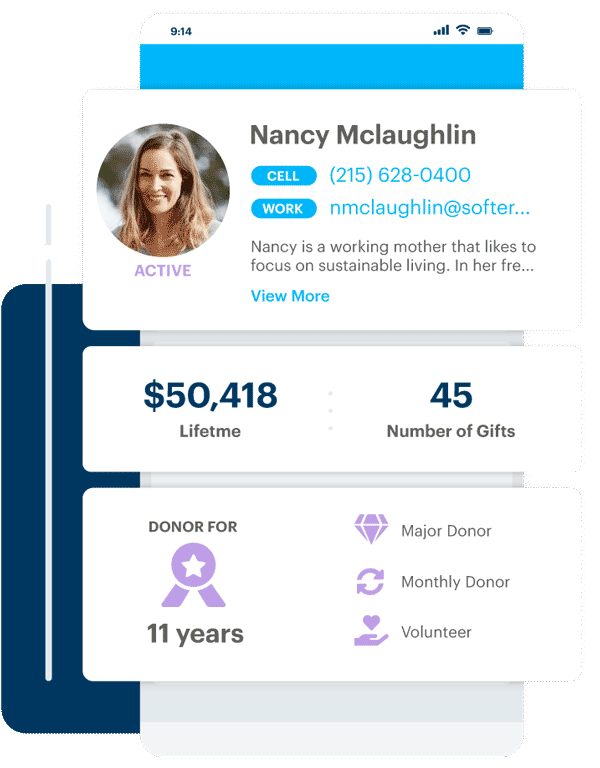Contributed by Mallory Erickson
Many new nonprofit organizations start out on the wrong foot by focusing on obtaining donations without the long-term plan of retaining donors. Securing a healthy relationship with donors who are willing to donate from year to year and quarter to quarter is pivotal in the success of any nonprofit.
Don’t get me wrong. Individuals and corporations who donate once are still amazing. However, nonprofits who connect with entities willing to donate regularly are the ones who build a sustainable future for their organization.
As it turns out, there is quite a bit that goes into retaining donors. It requires your nonprofit to proceed with unwavering confidence in its mission and unrelenting consistency.
In addition to utilizing fundraising software designed to help you increase donor engagement, it is important for nonprofits to establish a workflow of training volunteers to ensure they are using effective methods of obtaining and retaining donors. Nonprofits can gain a better view of how they can create a culture conducive to retaining donors by implementing executive coaching opportunities within their organization.
Executive coaching helps us dive deep into the work and mind shifts that need to be done to effectively retain donors. This process allows us to pinpoint and alter ineffective workflows while also addressing any emotions or aversions we have that could be holding our nonprofit back.
Check out our top executive coaching tips to ensure your nonprofit is operating effectively and heading in the direction of retaining donors!
Keep track of donors
Implementing a system to keep track of past donors and potential repeat donors is a great way to grow any nonprofit organization! Establishing an organized system to document donors, interactions, etc., will guide your future interactions with each donor and help you see trends across time. It’s beneficial to invest in a cohesive platform that allows you to both engage with donors effectively and create organization-wide to-do lists.

For example, DonorPerfect comes with contact management features that allow you to track donor engagements – when you last spoke, the method of communication, and recordings or notes from your meeting – then schedule a followup and assign it to a staff member. You can even use this feature to track which stage of the donor cycle your contact is currently in – identification, qualification, cultivation, solicitation, or stewardship!
Avoid the ineffective hustle
It happens to all of us! When faced with an uncomfortable situation, we often hyper-focus on staying busy with unimportant or irrelevant tasks to distract us from what is weighing on our minds. This happens in relationships where people busy themselves with housework to avoid uncomfortable conversations with their spouse or to escape feelings of anxiety or depression.
The same thing can happen within nonprofits as a whole and even on an individual level with volunteers! For example, a new nonprofit may hone in on having a ton of “first” meetings or get stuck in the planning stages rather than focusing on what is important— engaging with corporations and retaining donors.
As stated by MillenialTherapy, “sometimes we purposely pile on commitments or keep our scheduled so packed we barely sleep, so that we don’t have to face painful or unpleasant emotions.” Especially in the beginning, reaching out and having conversations with donors about money can be uncomfortable. The act of asking for money itself can be unsavory, not to mention the added risk of being rejected in the end.
As such, many nonprofits unintentionally establish habits and routines that allow them to avoid the inevitable task of addressing donor retention within their organization. They convince themselves that they are being highly productive without spending their time completing tasks that are the most beneficial for the longevity of the nonprofit.
Remember, while you are having your first meetings and over-planning workflows, your donors aren’t getting the attention they need to become retained contributors. To hear me talk more about hustle culture within nonprofits and a phenomenon I call the “Shiny New Funder Syndrome,” listen to Episode 40 of the What the Fundraising Podcast!
Be mindful of your donor goal
In light of the last section, it is important to move from packing your schedule with less important tasks to focusing more on your nonprofit’s donor goal. With every meeting your plan and every event you organize, your donor goal should be at the forefront of your mind.
To ensure you stick to the mission of retaining donors, you can ask yourself a series of questions. These questions will help you determine if what you are doing contributes to retaining contributors or if it is just a task to add to your busy schedule and make you feel like you are being productive.
Ask yourself:
- What can I do today to contribute to retaining more donors?
- Are the activities and events we’re planning mindfully created to retain donors?
- Am I/volunteers/organization spending our time wisely regarding donor retention?
- Is today planned around engaging with and contacting donors?
While administrative work and planning definitely need to be completed, engaging with donors should be at the top of your nonprofit’s list of priorities.
It has been discovered that nonprofits as a whole and even individual volunteers fall into making themselves “too busy” as a means to avoid uncomfortable conversations with donors. Read on for more insight on how to overcome the common fear of rejection!
Overcome the fear of rejection
According to PsychologyToday, “The fear of rejection is one of our deepest human fears. Biologically wired with a longing to belong, we fear being seen in a critical way.”
Unsurprisingly, engaging with donors and asking them to donate X amount to your nonprofit puts volunteers in a vulnerable position to feel rejection.
As stated by VeryWellMind, “Most people experience some nerves when placing themselves in situations that could lead to rejection, but for some people, the fear becomes overwhelming.” Therefore, it is likely that individuals within your nonprofit feel some sort of aversion (whether small or large) towards putting themselves out there while engaging with donors.
Nonprofits who avoid teaching their volunteers how to shift their mindset about rejection often find themselves with a low retention rate. This is because the fear of rejection prevents people from proceeding with confidence and conviction.
Overcoming rejection as a nonprofit organization:
- Develop an organization-wide mindset that rejection is not to be feared,
- Provide volunteers professional development to help them overcome this aversion,
- Offer continuous education and practice opportunities to build familiarity and comfort,
- Celebrate volunteers putting themselves out there and not just how much money they raise,
Once you establish a culture in your nonprofit that rejection is “okay,” you’ll see that confidence levels will also rise. This will have a domino effect and contribute to more funds being raised for your nonprofit’s cause. Your nonprofit will greatly benefit from volunteers who no longer shy away from donation conversations with contributors.
Break the cycle
Break the cycle of engaging in ineffective hustle activities that may be preventing your nonprofit from actually digging in and making measurable efforts to retain donors. Nonprofits who become self-aware of these potentially ineffective workflows can take the right steps to more efficient methods.
For more fundraising tips and tools from Mallory Erickson, check out her Resource page! Here, you can find relevant articles about fundraising in the nonprofit sector. In addition, you can subscribe to her new podcast What the Fundraising for ongoing conversations about how you can show up as a confident, embodied, and fearless fundraiser TODAY!

About Mallory
Mallory Erickson is an executive coach, fundraising consultant, and host of the podcast What the Fundraising, aimed at supporting nonprofit leaders to fundamentally change the way they lead and fundraise. Through her signature framework™ – Mallory provides unique tools to help nonprofit fundraise more from foundations, corporate partners, and individuals.






